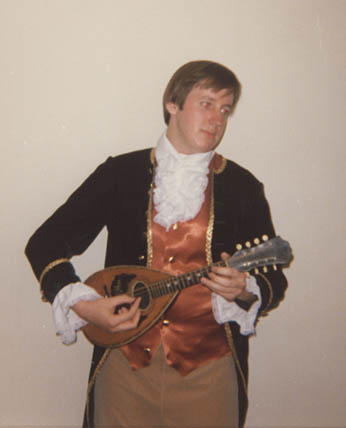This is an excerpt from a 2 part article I wrote for the CMSA Newsletter in 1985. This information is almost entirely from Oscar Sonneck's Early American Concert Life, published in 1949.
The mandolin first arrived in America at about the same time that it was beginning to become popular in Europe, during the second half of the 18th century. The earliest known performance on a mandolin in colonial America was given by Giovanni Gualdo, who had come here from Italy by way of England, where his "Six Easy Evening Entertainments" for 2 mandolins and harpsichord or cello were published (printed copy in Kings College, Cambridge, and an MS copy in the Library of Congress). He set up shop in Philadelphia as a wine merchant and music dealer in August 1767, and taught several different instruments, including the mandolin. His first concert was given on November 16, 1769 and included a "Solo upon the Mandolino, by Mr. Gualdo". He gave additional concerts on November 30, 1769 and October 12, 1770. Among the composers he played was Emanuele Barbella, so Gualdo may be responsible for the only complete surviving copy of Barbella's Six Duettos, now in the Library of Congress.
Unfortunately, Gualdo died in 1771 by "a Fall from his House" (as reported by Francis Hopkinson in a letter to John Penn), but not too long after his demise a few other mandolinists appeared. On June 17, 1774 a concert was given "for the benefit of Signor Sodi, first dancing master of the Opera in Paris and London, in which Mr. Vidal who has been a musician of the Chambers of the King of Portugal will play on diverse instruments of music". In the course of the concert, Vidal played "a duetto on the mandolino, accompanied with the violin." It should be pointed out that Signor Sodi was the brother of Carlo Sodi, who had performed on the mandolin at a Concert Spirituel in Paris in 1750. An additional mandolin concert was given in New York in 1774. After these concerts, I have no more references to the mandolin until it was re-introduced to American audiences a little over 100 years later. The mandolin had fallen out of favor in Europe in the mid 19th century, and the situation seems to have been the same here, although the necessary research to either confirm or disprove this has not yet been done.
If Barry is reading, maybe he can post his article.







 Reply With Quote
Reply With Quote








Bookmarks